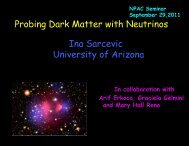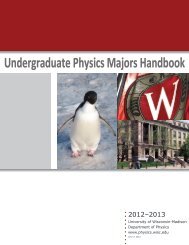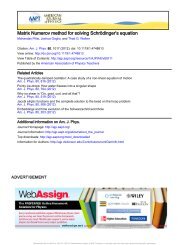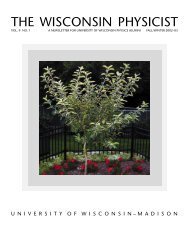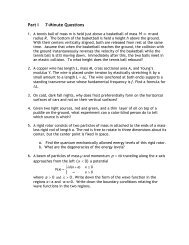T H E W I S C O N S I N P H Y S I C I S T - Department of Physics ...
T H E W I S C O N S I N P H Y S I C I S T - Department of Physics ...
T H E W I S C O N S I N P H Y S I C I S T - Department of Physics ...
Create successful ePaper yourself
Turn your PDF publications into a flip-book with our unique Google optimized e-Paper software.
CHAMBERLIN REMODELING<br />
NEARING COMPLETION<br />
by Michael Frayn, directed by Richard Corley<br />
— a Madison Premiere and winner <strong>of</strong> three “Tony Awards,” plus<br />
University <strong>of</strong> Wisconsin-sponsored educational “surround”<br />
activities.<br />
Presented by the Madison Repertory Theatre at the Overture<br />
Center, 201 State Street.<br />
Friday, Oct. 22, 2004 through Sunday, Nov. 14, 2004<br />
Educational “surround” events scheduled for Oct 23, Oct 27,<br />
Nov 3, Nov 7 & Nov 9, 2004.<br />
The University <strong>of</strong> Wisconsin College <strong>of</strong> Letters and Science<br />
and the Madison Repertory Theatre present to the University<br />
and greater Madison community a new experience — the<br />
blending <strong>of</strong> science and drama. As an introduction to the<br />
celebration <strong>of</strong> the World Year <strong>of</strong> <strong>Physics</strong> 2005 and in<br />
recognition <strong>of</strong> the 100th anniversary <strong>of</strong> Albert Einstein’s<br />
“Miraculous Year,” several departments, including <strong>Physics</strong>,<br />
Theatre and Drama, History <strong>of</strong> Science, Philosophy, and<br />
Science & Technology, have teamed up to enhance<br />
Madison’s opportunity to experience an award winning play<br />
about science by providing an educational “surround”<br />
intended to engage the further interest and concerns <strong>of</strong> the<br />
audience. These activities will range from pre-play and postplay<br />
discussions <strong>of</strong> the history, ethics and effects on today’s<br />
society to a public panel discussion. (See detailed calendar <strong>of</strong><br />
play and educational “surround” events at<br />
www.physics.wisc.edu/cope/index.html.)<br />
By Dave Huber<br />
The remodeling <strong>of</strong> Chamberlin Hall is close to being finished.<br />
Later in the fall the <strong>Department</strong> will begin moving <strong>of</strong>fices,<br />
instructional and research labs, and the physics museum from<br />
Sterling to remodeled areas in Chamberlin. It is expected that<br />
the move will take 6–8 months to complete. Beginning in<br />
the fall <strong>of</strong> 2005, all <strong>Physics</strong> lectures and classes will be held in<br />
Chamberlin. The <strong>Department</strong> will retain laboratory and <strong>of</strong>fice<br />
space in the basement <strong>of</strong> Sterling under the east wing. The<br />
remodeling <strong>of</strong> Sterling has been postponed; in the meantime,<br />
the space freed up by the move will be used by other<br />
departments and programs.<br />
Last spring, the Wisconsin Arts Board held an open<br />
competition for new artwork in Chamberlin under the<br />
“Percent for Art” program. The commission was awarded to<br />
an artist from Mineral Point for a “circular standing wave”<br />
bronze and stone sculpture that will be placed on the lawn<br />
outside the building.<br />
The <strong>Department</strong> will re-dedicate Chamberlin Hall as part <strong>of</strong> a<br />
<strong>Physics</strong> summerfest on August 12, 2005. All faculty, staff,<br />
students and alumni are invited. More information about the<br />
dedication can be found on page 1 in this newsletter.<br />
The play, winner <strong>of</strong> three Tony Awards including best play, is<br />
a haunting story <strong>of</strong> friendship and danger. In 1941 the<br />
German physicist Werner Heisenberg made a strange,<br />
clandestine trip to Copenhagen to see his Danish<br />
counterpart, Niels Bohr. Their work together on quantum<br />
mechanics and the uncertainty principle had revolutionized<br />
atomic physics in the 1920’s. But now the world had<br />
changed and the two men were on opposite sides in a world<br />
war. Scientists and historians always have argued about why<br />
Heisenberg went, and what the two men said.<br />
The Tony Award winning play that soars at the intersection <strong>of</strong><br />
science and art, “Copenhagen” is just an explosive reimagining<br />
<strong>of</strong> the mysterious wartime meeting between the<br />
two Nobel laureates to discuss the atomic bomb. Why<br />
“Copenhagen?” Because we are celebrating the World Year<br />
<strong>of</strong> <strong>Physics</strong> in 2005.<br />
Go to www.physics.wisc.edu for continuing calendar<br />
information throughout the 2005 year.<br />
New Chamberlin entrance<br />
4 U W – M A D I S O N P H Y S I C S


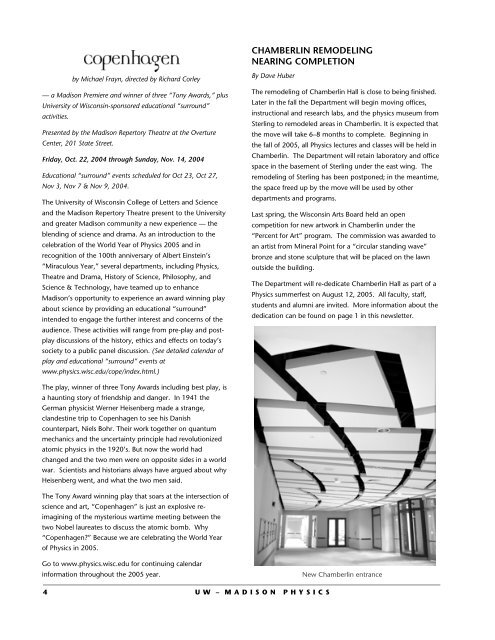

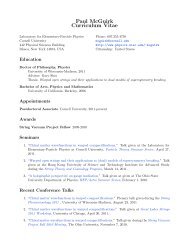
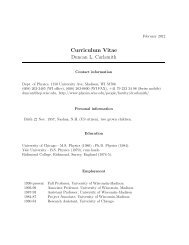
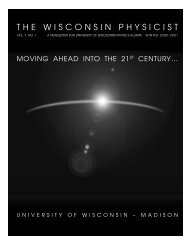
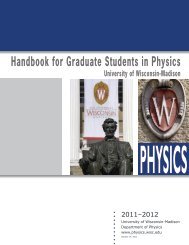


![The Symmetric Linear Potential [ ]](https://img.yumpu.com/25329322/1/190x245/the-symmetric-linear-potential-.jpg?quality=85)
